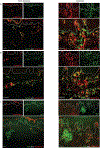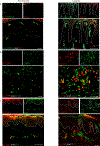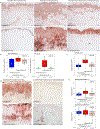Autoantigens ADAMTSL5 and LL37 are significantly upregulated in active Psoriasis and localized with keratinocytes, dendritic cells and other leukocytes
- PMID: 28482118
- PMCID: PMC6530461
- DOI: 10.1111/exd.13378
Autoantigens ADAMTSL5 and LL37 are significantly upregulated in active Psoriasis and localized with keratinocytes, dendritic cells and other leukocytes
Abstract
Psoriasis is a common immune-mediated disease that affects 2%-4% of individuals in North America and Europe. In the past decade, advances in research have led to an improved understanding of immune pathways involved in the pathogenesis of psoriasis and has spurred the development of targeted therapeutics. Recently, three psoriasis autoantigens have been described: cathelicidin (LL37), a disintegrin and metalloprotease domain containing thrombospondin type 1 motif-like 5 (ADAMTSL5), and lipid antigens generated by phospholipase A2 (PLA2) group IVD (PLA2G4D). It is important to establish the expression, regulation and therapeutic modulation of these psoriasis autoantigens. In this study, we performed immunohistochemistry and two-colour immunofluorescence on non-lesional and lesional psoriasis skin to characterize ADAMTSL5 and LL37, and their co-expression with T cells, dendritic cells, neutrophils and macrophages, which are the main immune cells that drive this disease. Our results showed that ADAMTSL5 and LL37 are significantly (P<.05) increased in lesional skin and are co-expressed by many dendritic cells, macrophages and some T cells in the dermis. Gene expression analysis showed significant (P<.05) upregulation of LL37 in lesional skin and significant downregulation following treatment with etanercept. ADAMTSL5 and LL37 are also significantly decreased by IL-17 or TNF-α blockade, suggesting feed-forward induction of psoriasis autoantigens by disease-related cytokines.
Keywords: ADAMTSL5; LL37/Cathelicidin; dendritic cells; macrophages; psoriasis.
© 2017 John Wiley & Sons A/S. Published by John Wiley & Sons Ltd.
Conflict of interest statement
Figures




Similar articles
-
Autoreactivity to self-antigens LL37 and ADAMTSL5 influences the clinical response to risankizumab in psoriatic patients.J Autoimmun. 2024 Jul;147:103244. doi: 10.1016/j.jaut.2024.103244. Epub 2024 May 25. J Autoimmun. 2024. PMID: 38797050
-
Current knowledge on autoantigens and autoantibodies in psoriasis.Scand J Immunol. 2020 Oct;92(4):e12945. doi: 10.1111/sji.12945. Scand J Immunol. 2020. PMID: 32697368 Review.
-
Alarmin function of cathelicidin antimicrobial peptide LL37 through IL-36γ induction in human epidermal keratinocytes.J Immunol. 2014 Nov 15;193(10):5140-8. doi: 10.4049/jimmunol.1302574. Epub 2014 Oct 10. J Immunol. 2014. PMID: 25305315
-
Cutaneous Expression of A Disintegrin-like and Metalloprotease domain containing Thrombospondin Type 1 motif-like 5 (ADAMTSL5) in Psoriasis goes beyond Melanocytes.J Pigment Disord. 2016 Oct;3(3):244. doi: 10.4172/2376-0427.1000244. Epub 2016 Sep 19. J Pigment Disord. 2016. PMID: 27857980 Free PMC article.
-
The contribution of IL-17 to the development of autoimmunity in psoriasis.Innate Immun. 2019 Aug;25(6):337-343. doi: 10.1177/1753425919852156. Epub 2019 May 24. Innate Immun. 2019. PMID: 31122103 Free PMC article. Review.
Cited by
-
Circular RNA circPFKP suppresses the proliferation and metastasis of gastric cancer cell via sponging miR-644 and regulating ADAMTSL5 expression.Bioengineered. 2022 May;13(5):12326-12337. doi: 10.1080/21655979.2022.2073001. Bioengineered. 2022. PMID: 35587154 Free PMC article.
-
Psoriasis pathogenesis and the development of novel targeted immune therapies.J Allergy Clin Immunol. 2017 Sep;140(3):645-653. doi: 10.1016/j.jaci.2017.07.004. J Allergy Clin Immunol. 2017. PMID: 28887948 Free PMC article. Review.
-
Topical astilbin ameliorates imiquimod-induced psoriasis-like skin lesions in SKH-1 mice via suppression dendritic cell-Th17 inflammation axis.J Cell Mol Med. 2022 Feb;26(4):1281-1292. doi: 10.1111/jcmm.17184. Epub 2022 Jan 12. J Cell Mol Med. 2022. PMID: 35023281 Free PMC article.
-
New Frontiers in Psoriatic Disease Research, Part I: Genetics, Environmental Triggers, Immunology, Pathophysiology, and Precision Medicine.J Invest Dermatol. 2021 Sep;141(9):2112-2122.e3. doi: 10.1016/j.jid.2021.02.764. Epub 2021 Jul 22. J Invest Dermatol. 2021. PMID: 34303522 Free PMC article. Review.
-
Characterization of the TCRβ repertoire of peripheral MR1-restricted MAIT cells in psoriasis vulgaris patients.Sci Rep. 2023 Nov 28;13(1):20990. doi: 10.1038/s41598-023-48321-z. Sci Rep. 2023. PMID: 38017021 Free PMC article.
References
-
- Parisi R, Symmons DPM, Griffiths CEM, Aschroft DM, Identification and Management of Psoriasis and Associated ComorbidiTy (IMPACT) project team. Global epidemiology of psoriasis: a systematic review of incidence and prevalence. J Invest Dermatol 2013;133(2):377–85. - PubMed
-
- Lowes MA, Bowcock AM, Krueger JG. Pathogenesis and therapy of psoriasis. Nature 2007;445(7130):866–73. - PubMed
-
- Boehncke W-H, Schön MP. Psoriasis. Lancet 2015;386(9997):983–94 - PubMed
MeSH terms
Substances
Grants and funding
LinkOut - more resources
Full Text Sources
Other Literature Sources
Medical
Miscellaneous

